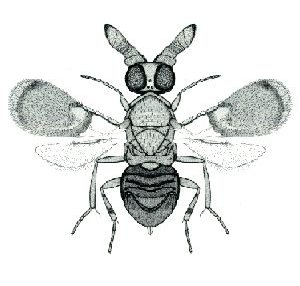
Chalcid wasps are insects within the superfamily Chalcidoidea, part of the order Hymenoptera. The superfamily contains some 22,500 known species, and an estimated total diversity of more than 500,000 species, meaning the vast majority have yet to be discovered and described. The name "chalcid" is often confused with the name "chalcidid", though the latter refers strictly to one constituent family, the Chalcididae, rather than the superfamily as a whole; accordingly, most recent publications (e.g.,) use the name "chalcidoid" when referring to members of the superfamily.

Alexandre Arsène Girault was an American entomologist specializing in the study of chalcid wasps. An eccentric and controversial figure, Girault was also a prolific and dedicated entomologist. He published more than 325 papers and described over 3000 new taxa from Australia.
Microlycus is a genus of hymenopteran insects of the family Eulophidae.

Anagyrus is a large genus of parasitic wasps from the family Encyrtidae. Anagyrus is distributed throughout the world. A subgenus of Anagyrus is known as Nesoanagyrus

Ablerus is the only genus in the family Azotidae. The genus was created by the American entomologist Leland Ossian Howard in 1894 for the species named in that year by William Harris Ashmead as Centrodora clisiocampae. The genus Azotus was synonymized with Ablerus by Alexandre Arsène Girault in 1913 and Hyatt synonymized Myocnemella with Ablerus in 1994, leaving Ablerus as the sole genus within the subfamily Azotinae. Azotinae was elevated in rank in 2013 to become the monotypic family Azotidae.
Gordon Gordh is an American entomologist.

Megastigmus is a genus of minute wasps. There are more than 134 described species, more than half of which undergo larval development within the seeds of trees and shrubs.

Encyrtinae is a subfamily of parasitic wasps in the family Encyrtidae.

Anicetus is a parasitic wasp genus in the subfamily Encyrtinae.

Anicetus communis is a parasitic wasp species in the genus Anicetus.

Cleonymus is a genus of wasps in the family Cleonymidae. There are more than 40 described species in the genus, which has been recorded on every continent except Antarctica.
John Stuart Noyes is a Welsh entomologist.
Austroencyrtus is a genus of parasitic wasps.

Ooencyrtus is a genus of chalcid wasp. William Harris Ashmead named and circumscribed the genus in 1900.

Psyllaephagus is a genus of chalcid wasps. It was named and circumscribed by William Harris Ashmead in 1900. As of 2019, Psyllaephagus contains approximately 245 species. They are found worldwide: Australia has 100 described species; the Palaearctic region has about 57 species, India has about 20, and Africa about 30.
Parachalcerinys is a genus of wasp. As of 2018, three species are recognized, which are all found in Australia.
Moorella is a genus of parasitoid wasps belonging to the family Encyrtidae within the superfamilia Chalcidoidea, in the order Hymenoptera.
Plutarchia is a genus of chalcid wasp in the subfamily Eurytominae. Alexandre Arsène Girault first circumscribed the genus in 1925; its name honors Plutarch. The genus initially only comprised its type species, P. bicarinativentris, found in Australia. Subsequent species from South Asia and Nigeria have been described and transferred to Plutarchia.

Cheiloneurus paralia is a species of chalcid wasp in the family Encyrtidae. It is found in Europe. It is a parasitoid of mealybugs.










